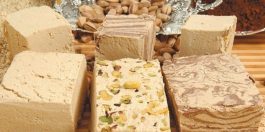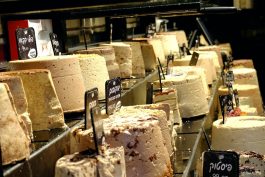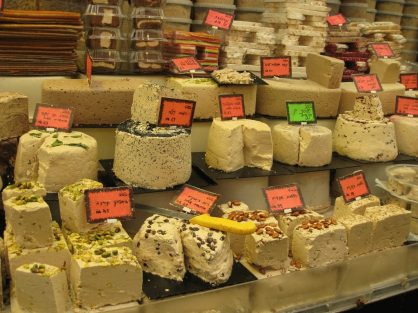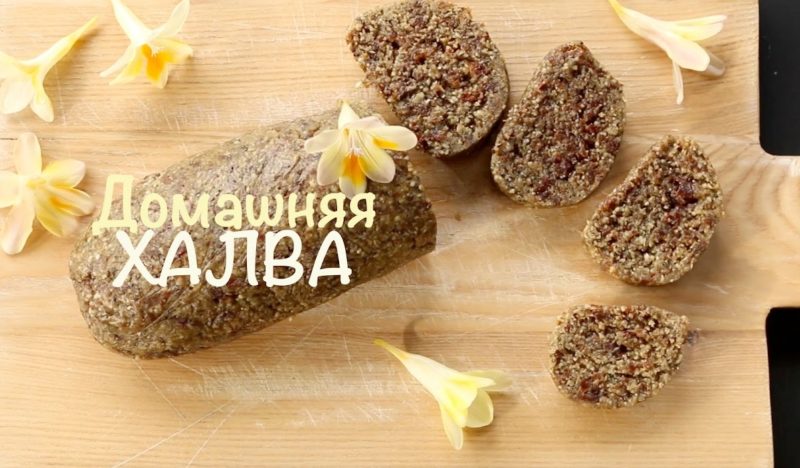In ancient times, halva was a necessary product for any traveler, because it is very high-calorie and does not deteriorate for a long time. What halva is made of today, it is interesting to know all the sweet tooth.
Material Content:
Composition and calorie halva
This is a dessert of Arab origin, which appeared around the beginning of the V century in Iran. There are many varieties of halva, but their calorie content is approximately the same - 100 grams of the product contains about 490-550 kcal.
 The composition includes vitamins and minerals, and indicators BZHU look like this:
The composition includes vitamins and minerals, and indicators BZHU look like this:
- proteins - 12-17 g;
- fats - 30 g;
- carbohydrates - 50 g;
Walnut halva contains a lot of dietary fiber (5-7 g per 100 g). The composition of Turkish white halva writing is slightly different, its calorie content is 450 kcal per 100 g, it contains few proteins (3 g) and fat (12 g), and consists mainly of carbohydrates (83 g).
Types of Eastern delicacies
There are several types of halva. The traditions of making this delicacy differ among different peoples. So, in Turkey, writing is similar to cotton candy, and in India they prepare vegetable halva from mung bean or calabash.
In the territory of the former Soviet Union, halva based on oil seeds and nuts is common.
Types of Oil Halva:
- sunflower;
- Peanut
- nutty;
- halva tahini from ground sesame seeds.
They also make tahini-peanut halva and walnut of various kinds: from pistachios, cashews, almonds, walnuts.
Benefits and harm to the body
You can talk about the benefits of halva for a long time, this product contains dietary fiber, which are necessary for normal digestion, vitamins and minerals.Oil halva contains all B vitamins that are important for the normal functioning of the nervous system, a lot of vitamin E, which helps to maintain healthy skin, hair and nails.
 It contains many mineral elements:
It contains many mineral elements:
- potassium - takes part in the regulation of intracellular metabolism and the processes of nerve impulses;
- magnesium - prevents the development of hypertension and heart disease;
- phosphorus - necessary for the mineralization of bones and teeth;
- iron - is part of many proteins and enzymes of the body;
- Manganese - is involved in the formation of connective and bone tissue;
- copper - prevents the development of connective tissue dysplasia;
- selenium - has an immunomodulatory effect;
- zinc - is part of hundreds of enzymes involved in the metabolism.
The harm of halva is high calorie content. For a person leading a sedentary lifestyle, it is enough to eat 25-30 grams of this sweet per day. Dessert is contraindicated for people with obesity and diabetes. Uzbek halva contains milk, it can not be consumed by persons with lactose intolerance.
It is best to buy halva in vacuum packaging, and store in the refrigerator. After the expiration date it is impossible to eat it.
How to cook halva in production
Initially, the peeled seeds are dried and fried in a special drum with constant stirring with a mechanical blade. Then the seeds are sent to the extruder to thoroughly grind the kernels to a pasty state. Grinding is carried out several times until the mass (halvin) becomes liquid, vanilla is added at the end.
To turn liquid paste into solid halva, confectioners make caramel from syrup on water, sugar and molasses. Then a soap root is added to the thick mass of the finished syrup. After shaking, a thick, elastic, snow-white foam is obtained.
This caramel foam is combined with halvin, carefully kneaded by hand with special oars, caramel threads are pulled so that the halva is airy and fibrous-layered. The finished product is immediately packaged. Sweets are made from part of the dessert, divided into cubes and covered with chocolate.
Best Home Recipes
In real oil halva there is no flour, in order to make it correctly, you need to know not only the products that make up the composition, but also the manufacturing technology.
Homemade Sunflower Halva Recipe
- sunflower seeds - 500 g;
- sugar - 250 g;
- vanillin - 1 pack;
- egg - 1 protein;
- water - 70 ml.
Cooking:
- Fry the seeds in a cast-iron skillet. The fire is done medium, fried for 10-15 minutes until golden brown and a pleasant smell.
- Transfer the sunflower seeds into a cup, grind to a puree condition using a hand blender. Grains should not be felt in the finished mass.
- Syrup is boiled from sugar and water to a temperature of 120 ° C. To check readiness, a drop of mass is immersed in cold water, it should harden and become viscous.
- The protein is whipped until a white, stable foam. Then, without turning off the mixer, the finished syrup is poured into the protein mass.
- Combine the ground mass of seeds, vanillin and protein caramel in one bowl. Mix with a spoon, raising it as high as possible so that halva turns out to be fibrous.
- When the mass becomes homogeneous, transfer it to a mold and put in the refrigerator for solidification for 10 minutes.
To taste, home halva is very fragrant, not too sweet. Sweet tooth should add more sugar. In such halva, before putting it into shape and putting it in the refrigerator, you can put raisins, cocoa or pieces of dried apricots.
Sunflower halva with sesame seeds
Products:
- sunflower seeds peeled and fried - 350 g;
- sesame seeds - 50 g;
- liquid honey - how many seeds will they take?
Cooking:
- Sesame and seeds are ground in a coffee grinder.
- Transfer to a bowl.
- So much liquid honey is added so that the mass can be kneaded like a tough, uniform dough.
- The resulting halva is wrapped in cling film and sent to the refrigerator for 2 hours.
Homemade halva is very tasty, satisfying and healthy. From it comes the aroma of honey and fresh seeds. The ratio and quantity of sesame seeds, sunflowers can be changed at your discretion.
















